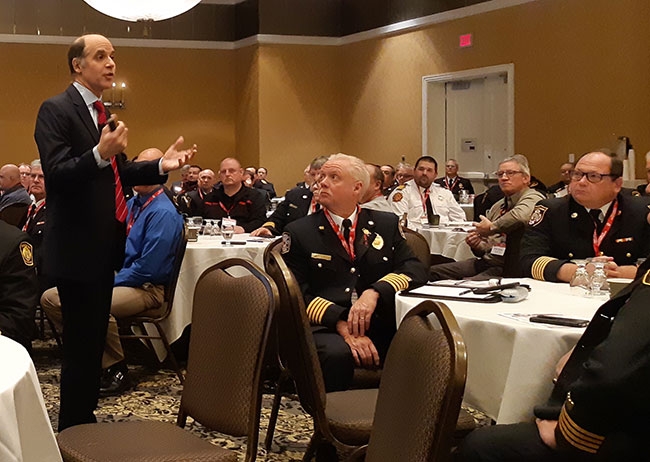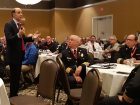
Association news
News
OAFC General Meeting
Fire service leaders from across Ontario gathered at the Hilton Niagara Falls hotel Nov. 20 to 22 for the 2018 annual general meeting of the Ontario Association of Fire Chiefs (OAFC).
February 1, 2019
By
Grant Cameron
 Chris Ulrich Fire service leaders from across Ontario gathered at the Hilton Niagara Falls hotel Nov. 20 to 22 for the 2018 annual general meeting of the Ontario Association of Fire Chiefs (OAFC). By Grant Cameron
Chris Ulrich Fire service leaders from across Ontario gathered at the Hilton Niagara Falls hotel Nov. 20 to 22 for the 2018 annual general meeting of the Ontario Association of Fire Chiefs (OAFC). By Grant CameronThe event featured meetings, speakers, educational presentations and interactive roundtable sessions that allowed operational, planning and management professionals from fire departments across the province to discuss current and emerging issues and challenges in the fire service.
Ontario Labour Minister Laurie Scott said in remarks at the meeting that the province stepped up to the plate with legislation that allows full-time firefighters to volunteer as firefighters in their communities.
“Our government is enshrining the right of full-time firefighters to work wherever they want,” she said in her speech. “Never again will our heroes be prosecuted for volunteering in their communities.”
The Restoring Trust, Transparency and Accountability Act, 2018, or Bill 57, allows full-time firefighters to volunteer on the side without being disciplined, fined or suspended. The Fire Protection and Prevention Act, 1997 had prohibited full-time firefighters from serving as volunteers, a practice known as “two-hatting” or “double-hatting.”
Scott said smaller communities simply don’t have the resources and need the legislation in place.
She noted that 60 per cent of Ontario’s firefighters are volunteers, so hundreds if not thousands of professional firefighters are double-hatting in the province, and Bill 57 will protect them from penalties.
“Ontario needs a mix of professional and volunteer firefighters. These changes mean double-hatters will not be disciplined by their association.”
Scott said fire chiefs across the province rely on double-hatters and, if eliminated, public safety would suffer.
“Bill 57 finally gives firefighters the protection they deserve. This freedom to protect freedom is compelling.”
The provincial government calculates there are 19,000 volunteers serving in 410 of 441 fire departments, meaning a full 90 per cent of Ontario’s municipalities count on volunteer responders.
Scott noted that Bill 57 also changes the arbitration process and replaces the present three-member arbitration boards with single arbitrators for dispute resolution, similar to the police sector.
She said that, in the past, there have been unreasonable delays.
“Firefighters and municipalities deserve better,” she said. “Working people should have confidence in predictable and reasonable regulations.”
Keynote speaker at the event was Chris Ulrich, a senior instructor at the Body Language Institute who trains executives and entrepreneurs on how to use body language to transform their presence.
Ulrich gave fire chiefs numerous examples of how to read body language and instantly connect with people and noted it’s important for fire chiefs to understand and pick up signs so they can build rapport and get their messages across to municipal leaders and firefighters.
For example, he noted, when a person answers a question but shrugs his or her shoulders it shows uncertainty and there is often more to the story, and when someone rubs their neck or one part of the body touches another, it’s a way of dealing with stress and an indication that more is going on.
When a person stands in the middle of a group or in a “Superman” pose with their hands on their hips it’s often a sign of power, he said, and if their hands are on their hips with one foot forward it’s usually an indication that there’s somewhere else they’d rather be.
Ulrich said it’s important for fire service leaders to be aware of such gestures because they often provide a clue into what’s really going on with a person.
The face, he said, can show seven main emotions – fear, contempt, disgust, anger, sadness, happiness and surprise, so fire service leaders can look for those when trying to build rapport with someone.
“The face will leak our emotions,” said Ulrich. “If I can spot that, I know there’s more to the story than what’s going on.”
Also at the conference:
- Ottawa Fire Services Chief Kim Ayotte spoke about the response to six tornadoes that touched down in the Ottawa-Gatineau area in September 2018, injuring dozens of people and damaging and demolishing numerous houses and buildings.
- Ontario Fire Marshal and Chief of Emergency Management Ross Nichols gave an update on activities and work being undertaken by the Office of the Fire Marshal and Emergency Management
- NFPA Canadian public education representative Laura King talked about community risk reduction and why it matters to fire chiefs and departments.
- White Rock Fire Rescue Chief Phil Lemire gave an overview of the B.C. Fire Service minimum training standards for structure firefighters as defined by the British Columbia Structure Firefighter Competency and Training Playbook.
- Niagara-on-the-Lake Fire & Emergency Services Chief Rob Grimwood gave an update on work being done by the Ontario Fire Services Section 21 Committee.
Note: The OAFC Annual Conference & Trade Show will be held May 3 to 4, 2019 in Mississauga, Ont., and FireCon 2019 will be held Sept. 5 to 7, 2019 in Thunder Bay, Ont. For more information about the events, go to www.oafc.on.ca.
Print this page

